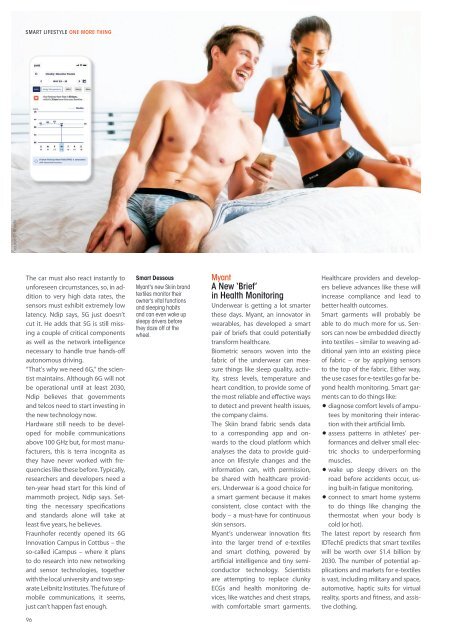Smart Industry No.1 2022
Smart Industry No.1 2022 - The IoT Business Magazine - powered by Avnet Silica
Smart Industry No.1 2022 - The IoT Business Magazine - powered by Avnet Silica
Create successful ePaper yourself
Turn your PDF publications into a flip-book with our unique Google optimized e-Paper software.
<strong>Smart</strong> Lifestyle One More Thing<br />
source ©: Khachi<br />
The car must also react instantly to<br />
unforeseen circumstances, so, in addition<br />
to very high data rates, the<br />
sensors must exhibit extremely low<br />
latency. Ndip says, 5G just doesn’t<br />
cut it. He adds that 5G is still missing<br />
a couple of critical components<br />
as well as the network intelligence<br />
necessary to handle true hands-off<br />
autonomous driving.<br />
“That's why we need 6G," the scientist<br />
maintains. Although 6G will not<br />
be operational until at least 2030,<br />
Ndip believes that governments<br />
and telcos need to start investing in<br />
the new technology now.<br />
Hardware still needs to be developed<br />
for mobile communications<br />
above 100 GHz but, for most manufacturers,<br />
this is terra incognita as<br />
they have never worked with frequencies<br />
like these before. Typically,<br />
researchers and developers need a<br />
ten-year head start for this kind of<br />
mammoth project, Ndip says. Setting<br />
the necessary specifications<br />
and standards alone will take at<br />
least five years, he believes.<br />
Fraunhofer recently opened its 6G<br />
Innovation Campus in Cottbus – the<br />
so-called iCampus – where it plans<br />
to do research into new networking<br />
and sensor technologies, together<br />
with the local university and two separate<br />
Leibnitz Institutes. The future of<br />
mobile communications, it seems,<br />
just can’t happen fast enough.<br />
<strong>Smart</strong> Dessous<br />
Myant's new Skiin brand<br />
textiles monitor their<br />
owner's vital functions<br />
and sleeping habits<br />
and can even wake up<br />
sleepy drivers before<br />
they doze off at the<br />
wheel.<br />
Myant<br />
A New ‘Brief’<br />
in Health Monitoring<br />
Underwear is getting a lot smarter<br />
these days. Myant, an innovator in<br />
wearables, has developed a smart<br />
pair of briefs that could potentially<br />
transform healthcare.<br />
Biometric sensors woven into the<br />
fabric of the underwear can measure<br />
things like sleep quality, activity,<br />
stress levels, temperature and<br />
heart condition, to provide some of<br />
the most reliable and effective ways<br />
to detect and prevent health issues,<br />
the company claims.<br />
The Skiin brand fabric sends data<br />
to a corresponding app and onwards<br />
to the cloud platform which<br />
analyses the data to provide guidance<br />
on lifestyle changes and the<br />
information can, with permission,<br />
be shared with healthcare providers.<br />
Underwear is a good choice for<br />
a smart garment because it makes<br />
consistent, close contact with the<br />
body – a must-have for continuous<br />
skin sensors.<br />
Myant’s underwear innovation fits<br />
into the larger trend of e-textiles<br />
and smart clothing, powered by<br />
artificial intelligence and tiny semiconductor<br />
technology. Scientists<br />
are attempting to replace clunky<br />
ECGs and health monitoring devices,<br />
like watches and chest straps,<br />
with comfortable smart garments.<br />
Healthcare providers and developers<br />
believe advances like these will<br />
increase compliance and lead to<br />
better health outcomes.<br />
<strong>Smart</strong> garments will probably be<br />
able to do much more for us. Sensors<br />
can now be embedded directly<br />
into textiles – similar to weaving additional<br />
yarn into an existing piece<br />
of fabric – or by applying sensors<br />
to the top of the fabric. Either way,<br />
the use cases for e-textiles go far beyond<br />
health monitoring. <strong>Smart</strong> garments<br />
can to do things like:<br />
• diagnose comfort levels of amputees<br />
by monitoring their interaction<br />
with their artificial limb.<br />
• assess patterns in athletes’ performances<br />
and deliver small electric<br />
shocks to underperforming<br />
muscles.<br />
• wake up sleepy drivers on the<br />
road before accidents occur, using<br />
built-in fatigue monitoring.<br />
• connect to smart home systems<br />
to do things like changing the<br />
thermostat when your body is<br />
cold (or hot).<br />
The latest report by research firm<br />
IDTechE predicts that smart textiles<br />
will be worth over $1.4 billion by<br />
2030. The number of potential applications<br />
and markets for e-textiles<br />
is vast, including military and space,<br />
automotive, haptic suits for virtual<br />
reality, sports and fitness, and assistive<br />
clothing.<br />
source ©: Skiin<br />
96
















